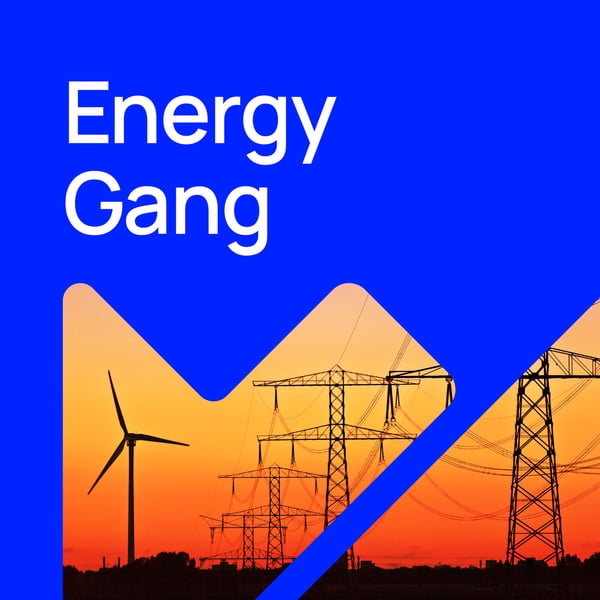The extraordinary resurgence of concentrated solar power
The Energy Gang
Wood Mackenzie
4.6 • 1.3K Ratings
🗓️ 6 August 2024
⏱️ 57 minutes
🧾️ Download transcript
Summary
Complex, outdated, expensive: concentrating solar power used to be a clunky way of harnessing the sun. What’s changed to now make it viable?
Concentrating Solar Power, or CSP, takes energy from the sun, converts it to heat, and uses it to drive a turbine to provide renewable electricity. It has more moving parts than photovoltaic (PV) solar – which has none – so there is more that can go wrong. But it has the big advantage that the heat can be stored for days, weeks and even months, meaning that CSP can support grid stability even when the sun isn’t shining. Its real competition isn’t PV solar, but other “clean firm” power sources such as geothermal.
The US Department of Energy is funding 25 projects in this area, with almost $100 million to research and develop CSP technologies. To discuss the technology and the viability of a process that’s been trying to get off the ground in the US for decades, Melissa Lott and Amy Myers-Jaffe are joined by Dr Matt Bauer from the Solar Energy Technologies Office.
They explore the different generations of CSP technology, with Gen 3 focusing on higher temperature heat and more efficient power cycles. The steep learning curve and capital intensity of CSP plants is a particular barrier to deployment at the moment, as is the risk associated with building large thermal plants. The potential for CSP to bridge seasonal energy storage gaps is there; unlocking it is the problem.
See Privacy Policy at https://art19.com/privacy and California Privacy Notice at https://art19.com/privacy#do-not-sell-my-info.
Transcript
Click on a timestamp to play from that location
| 0:00.0 | Hello and I'm a professor at the Climate School at Columbia University and to many of you you're used to my voice but not in this position on the show. I'm filling in for Ed who is on vacation and Ed I hope you're having a great time and look forward to seeing you back behind the mic when you're back but hope you're enjoying your travels. |
| 0:23.0 | I'm really excited to be joined today by another frequent voice on the energy gang, Amy Jaffey. |
| 0:28.0 | Hey Amy, how are you this morning? |
| 0:29.0 | I'm good, Melissa, but you know, you're talking about the heat in New York. |
| 0:32.0 | Last week I was teaching a summer intensive down at |
| 0:35.8 | NYU and the train stopped because of the heat related signal problem and I thought oh no how am I going to reach my students so they know what happened |
| 0:49.5 | but luckily there was someone from my opposite NYU who I could send down to the classroom and start them on a topical video we were going to watch anyway and then luckily Metro North came up with a crew to fix the signal within 40 minutes so I wasn't that |
| 1:07.3 | late because I'd left a lot of time. That's good. It's good to leave buffers right now. |
| 1:11.3 | I will say the number of heat related things I've been running to in the last few weeks has definitely increased. |
| 1:17.4 | As a another person with Texas Roots and Texas Connections I think heat I'm like no big deal right but then when you saw the |
| 1:25.8 | humidity on it put a lot of pavement around you and add a lot of systems including |
| 1:30.3 | public transport it definitely gets complicated question summer intensive, I think you had one of my colleagues, Gautam Jane teaching parts of it? |
| 1:38.0 | Am I right? I did have Gautam come and give a gift lecture on the Green Bonds market and why they are failing to address the |
| 1:46.4 | fragility nexus that happens to indebted low-income countries as they face higher climate change challenges which |
| 1:56.8 | then contribute to their spiral of debt and difficulty raising finance they need to address loss and |
| 2:04.8 | damage and adaptation. |
| 2:06.4 | Yeah, as always, I really, really want to go into this topic, |
| 2:09.0 | but I'm going to pause. |
| 2:10.6 | Put that to the side for the minute, |
| 2:11.8 | because we have some great stuff to discuss today with our other guest. |
| 2:15.0 | So please to introduce Dr. Matt Bauer, who's part of the Solar Energy Technologies Office at the Department of Energy. |
| 2:21.0 | So welcome Matt. It's great to have you here. |
... |
Please login to see the full transcript.
Disclaimer: The podcast and artwork embedded on this page are from Wood Mackenzie, and are the property of its owner and not affiliated with or endorsed by Tapesearch.
Generated transcripts are the property of Wood Mackenzie and are distributed freely under the Fair Use doctrine. Transcripts generated by Tapesearch are not guaranteed to be accurate.
Copyright © Tapesearch 2025.

